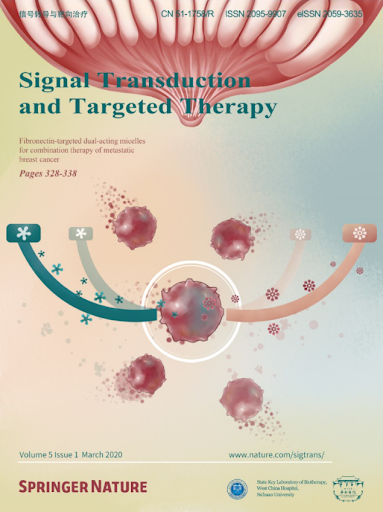Pseudohypoxic stabilization of HIF1α via cyclophilin D suppression promotes melanoma metastasis.
IF 52.7
1区 医学
Q1 BIOCHEMISTRY & MOLECULAR BIOLOGY
引用次数: 0
Abstract
Stabilization of hypoxia-inducible factor 1 alpha (HIF1α), which plays a pivotal role in regulating cellular responses to insufficient oxygen, is implicated in cancer progression, particularly epithelial-mesenchymal transition and metastatic dissemination. Despite its crucial role in tumorigenesis, the precise mechanisms governing HIF1α stabilization under varying tumor microenvironmental conditions are not fully understood. In this study, we show that stabilization of HIF1α in metastasizing melanoma under mild hypoxia is regulated primarily by mitochondrial reactive oxygen species (ROS) rather than by reduced oxygen levels. Activated HIF1α suppresses the expression of cyclophilin D (CypD), a regulator of the mitochondrial permeability transition pore (mPTP), as a reciprocal regulatory mechanism to sustain HIF1 signaling via upregulation of microRNAs miR-23a and miR-27a. Reduced expression of CypD leads to mPTP closure, resulting in elevated mitochondrial calcium accumulation and enhanced oxidative phosphorylation, which in turn increases mitochondrial ROS levels. The ROS then inhibits a prolyl hydroxylase, establishing a pseudohypoxic state that stabilizes HIF1α even in the presence of oxygen. This HIF1-reinforced and mitochondria-driven pseudohypoxic induction is essential for maintaining HIF1 signaling under conditions of mild hypoxia or transient increases in oxygen levels during melanoma metastasis. Overexpression of CypD reversed the pseudohypoxic state and potently inhibited melanoma metastasis. Thus, mitochondria-driven pseudohypoxic induction is critical for sustaining HIF1 signaling in metastasizing cancer cells and can be exploited to develop anti-metastatic therapies.通过亲环蛋白D抑制HIF1α的假性缺氧稳定促进黑色素瘤转移。
低氧诱导因子1α (HIF1α)的稳定在调节细胞对缺氧的反应中起关键作用,与癌症进展,特别是上皮-间质转化和转移传播有关。尽管它在肿瘤发生中起着至关重要的作用,但在不同的肿瘤微环境条件下控制HIF1α稳定的确切机制尚不完全清楚。在这项研究中,我们发现轻度缺氧下转移性黑色素瘤中HIF1α的稳定主要由线粒体活性氧(ROS)调节,而不是通过降低氧水平。激活的HIF1α抑制亲环蛋白D (CypD)的表达,CypD是线粒体通透性过渡孔(mPTP)的调节因子,作为通过上调microrna miR-23a和miR-27a来维持HIF1信号传导的互惠调节机制。CypD表达降低导致mPTP关闭,导致线粒体钙积累升高,氧化磷酸化增强,进而增加线粒体ROS水平。然后,ROS抑制脯氨酸羟化酶,建立假缺氧状态,即使在氧气存在的情况下也能稳定HIF1α。这种HIF1增强和线粒体驱动的假性缺氧诱导对于在轻度缺氧或黑色素瘤转移过程中氧水平短暂升高的条件下维持HIF1信号传导至关重要。CypD过表达可逆转假性缺氧状态,并有效抑制黑色素瘤转移。因此,线粒体驱动的假性缺氧诱导对于维持转移癌细胞中的HIF1信号至关重要,并且可以用于开发抗转移疗法。
本文章由计算机程序翻译,如有差异,请以英文原文为准。
求助全文
约1分钟内获得全文
求助全文
来源期刊

Signal Transduction and Targeted Therapy
Biochemistry, Genetics and Molecular Biology-Genetics
CiteScore
44.50
自引率
1.50%
发文量
384
审稿时长
5 weeks
期刊介绍:
Signal Transduction and Targeted Therapy is an open access journal that focuses on timely publication of cutting-edge discoveries and advancements in basic science and clinical research related to signal transduction and targeted therapy.
Scope: The journal covers research on major human diseases, including, but not limited to:
Cancer,Cardiovascular diseases,Autoimmune diseases,Nervous system diseases.
 求助内容:
求助内容: 应助结果提醒方式:
应助结果提醒方式:


